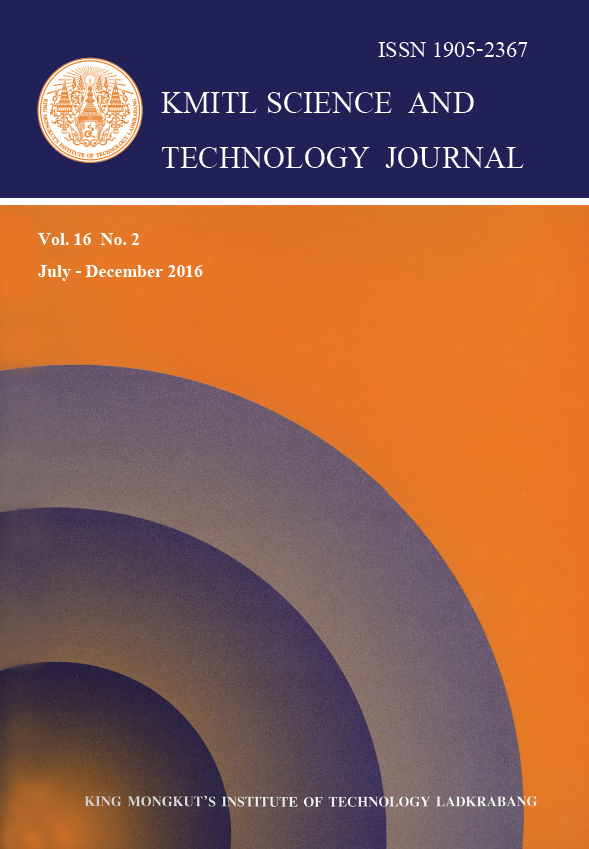Surface Wettability of Silica Films Modified by UV/Ozone Treatment
Main Article Content
Abstract
Surface wettability of silica films was modified by UV/Ozone treatment. The silica films were prepared by dip-coating process using tetraethylorthosilicate (TEOS) as starting precursor. The TEOS was dissolved in mixing solution of absolute ethanol, deionized water and ammonia and then hydrochloric acid was added as the hydrolysis catalyst. The mixed solution was coated on glass substrates by dip coating process operated at 30 mm/min and heated at 100 °C. After that, the deposited films were exposed in UV/Ozone generator at different time treatment. The effects of time treatment on surface wettability, and optical properties of modified silica films were investigated by contact angle measurement, UV-Vis spectrophotometer. The contact angle of silica films was decreased after UV/Ozone treatment. These results implied that surface wettability of silica films was significantly improved by UV/Ozone treatment due to the oxidization its surface.
Keywords: UV/Ozone, silica films, surface wettability
*Corresponding author: Tel.: +66 863360154 Fax: +66 23298265
E-mail: russameeruk@gmail.com
Article Details
Copyright Transfer Statement
The copyright of this article is transferred to Current Applied Science and Technology journal with effect if and when the article is accepted for publication. The copyright transfer covers the exclusive right to reproduce and distribute the article, including reprints, translations, photographic reproductions, electronic form (offline, online) or any other reproductions of similar nature.
The author warrants that this contribution is original and that he/she has full power to make this grant. The author signs for and accepts responsibility for releasing this material on behalf of any and all co-authors.
Here is the link for download: Copyright transfer form.pdf
References
[2] Ye, H., Zhang, X., Zhang, Y., Ye, L., Xiao, B., Lv, H. and Jiang, B., 2011. Preparation of antireflective coatings with high transmittance and enhanced abrasion-resistance by a base/acid two-step catalyzed sol-gel process. Solar Energy Materials and Solar Cells, 95, 23472351.
[3] Zhang, X., Zheng, F., Ye, L., Xiong, P., Yan, L., Yang, W. and Jiang, B., 2014. A one-pot sol-gel process to prepare a superhydrophobic and environment-resistant thin film from ORMOSIL nanoparticles. RSC Advances, 4, 9838-9841.
[4] Yao, L. and He, J., 2014. Recent progress in antireflection and selfcleaning technology–From surface engineering to function surfaces. Progress in Materials Science, 61, 94143.
[5] Xin, C., Peng, C., Xu, Y. and Wu, J., 2013. A novel route to prepare weather resistant, durable antireflective films for solar glass. Solar Energy, 93, 121126.
[6] Shi, X., Xu, L., Le, T.B., Zhou, G., Zheng, C., Tsuru, K. and Ishikawa, K., 2016. Partial oxidation of TiN coating by hydrothermal treatment and ozone treatment to improve its osteoconductivity.Materials science and Engineering C, 59, 542548.
[7] Lu, X., Wang, Z., Yang, X., Xu, X., Zhang, L., Zhao, N. and Xu, J., 2011. Antifogging and antireflective silica film and its application on solar modules. Surface and Coating Technology, 206, 14901494.
[8] Noonuruk, R., Techitdheera, W. and Pecharapa, W., 2012. Characterization and ozone-induced coloration of ZnxNi1-xO thin films prepared by sol-gel method. Thin Solid Films, 520, 27692775.
[9] Wenzel, R.N., 1936. Resistance of solid surfaces to wetting by water.Industrial and Engineering Chemistry, 28, 988994.
[10] So, S.K., Choi, W.K., Cheng, C.H., Leung, L.M. and Kwong, C.F., 1999. Surface preparation for organic electroluminescent devices.Applied Physice A: Materials Science and Processing, 68, 447450.


